How To Add Programs To Mega2560 R3 Bootloader
Overview
Do you have a bricked Arduino that won't accept lawmaking anymore? Or, perhaps you lot wrote your ain firmware and would similar to upload information technology to your Arduino? Or, maybe you only desire to larn more than about the inner-workings of Arduino, AVR, and microcontrollers in general. Well, yous're in luck! This tutorial will teach you lot what a bootloader is, why you would need to install/reinstall information technology, and get over the process of doing so.
Suggested Reading
You lot may want to check out these tutorials earlier continuing down the bootloader path.
- What is an Arduino
- Installing the Arduino IDE
What is a Bootloader?
Atmel AVRs are groovy little ICs, but they can be a bit tricky to plan. Yous need a special developer and some fancy .hex files, and its not very beginner friendly. The Arduino has largely done away with these issues. They've put a .hex file on their AVR chips that allows you to plan the board over the serial port, meaning all yous need to programme your Arduino is a USB cable.
The bootloader is basically a .hex file that runs when you turn on the board. It is very similar to the BIOS that runs on your PC. It does two things. First, it looks around to come across if the computer is trying to program information technology. If it is, information technology grabs the programme from the computer and uploads it into the ICs memory (in a specific location so equally not to overwrite the bootloader). That is why when you try to upload code, the Arduino IDE resets the chip. This basically turns the IC off and back on again so the bootloader tin start running again. If the estimator isn't trying to upload code, it tells the chip to run the code that's already stored in memory. In one case it locates and runs your program, the Arduino continuously loops through the plan and does so equally long equally the board has ability.
Why Install a Bootloader
If you are edifice your own Arduino, or need to replace the IC, yous will demand to install the bootloader. Y'all may too have a bad bootloader (although this is very rare) and demand to reinstall the bootloader. At that place are too cases where you've put your board in a weird setting and reinstalling the bootloader and getting it back to factory settings is the easiest mode to fix it. We've seen boards where people have turned off the series port meaning that there is no manner to upload code to the board, while there may be other ways to fix this, reinstalling the bootloader is probably the quickest and easiest. Like I said, having a bad bootloader is actually very very rare. If you have a new board that isn't accepting code 99.ix% of the time its not the bootloader, but for the 1% of the time it is, this guide volition help you set up that problem.
Selecting a Programmer
We are going to talk nearly ii unlike types of programmers you can employ to install or reinstall bootloaders.
Choice 1: Dedicated Programmers
For a quick like shooting fish in a barrel programmer we recommend looking into the AVR Pocket Developer (Windows only).
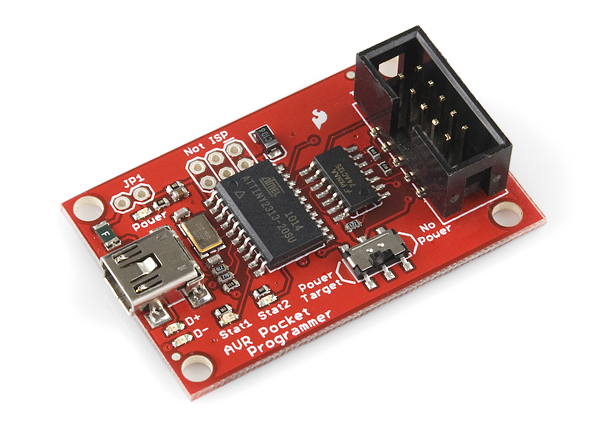
Or, y'all can use the official Atmel AVR MKII programmer (Now discontinued) or the Atmel JTAG ICE3 programmer.
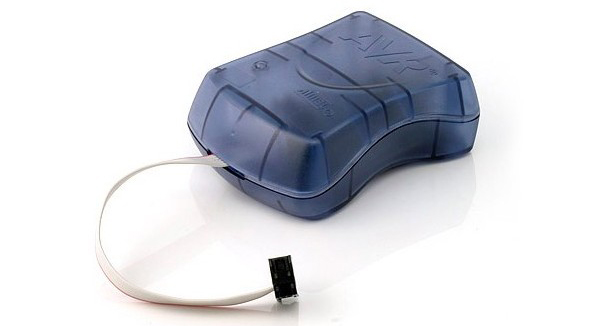
AVR MKII
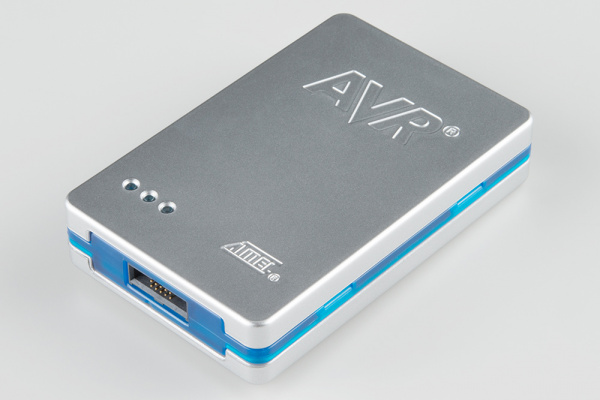
JTAG ICE3
The AVR Pocket Programmer or virtually cheaper options volition work just fine for most applications, merely they may have problems with some boards, specifically ones with lots of retentivity like the ATMega2560 based boards.
Selection 2: Using the Arduino equally a Developer
The other option is grabbing an Arduino Uno (or Duemilanove). If you go into the Arduino IDE you will encounter an example sketch called'Arduino as Isp.' If you lot upload this code to your Arduino, it will basically human activity equally an AVR programmer. This isn't really recommended for production of boards, or boards with lots of memory, but, in a pinch, information technology works pretty well. Besides as of this writing the lawmaking but works on ATmega328 boards. Perchance one mean solar day it will work on the Leonardo or Due, but not yet.
Connecting the Programmer
In-Excursion Series Programming (ICSP)
It'southward very uncommon to program ICs before they are soldered onto a PCB. Instead, nearly microcontrollers have what'south called an in-system programming (Internet access provider) header. Particularly, some IC manufacturers, such as Atmel and Microchip, have a specialized Internet service provider method for programming their ICs. This is referred to as in-circuit serial programming (ICSP) Most Arduino and Arduino compatible boards will have a 2x3 pin ICSP header on them. Some may fifty-fifty accept more than one depending on how many ICs live on the PCB. It breaks out three of the SPI pins (MISO, MOSI, SCK), and power, basis, and reset. These are the pins you lot'll need to connect your programmer to in club to reflash the firmware on your board.
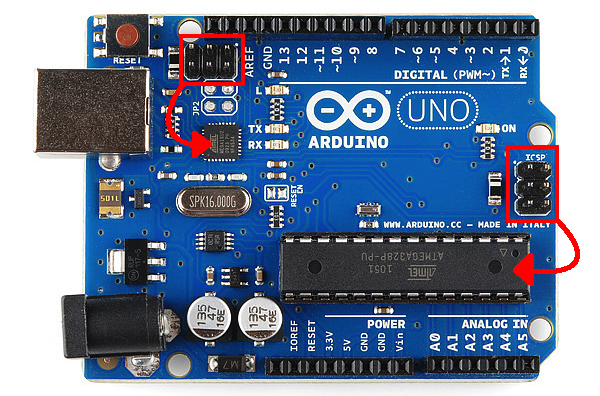
Here we accept the Arduino Uno R3. It has two ICSP headers: one for the ATmega16U2 and i for the ATmega328. To reflash the bootloader on this lath, yous would use only the ICSP header for the ATmega328.
On some smaller boards you may not see this connector, only the pins should be broken out elsewhere. Whether you lot're using an SMD IC or a DIP IC, the Isp pins should be attainable in one form or another. Some boards might only have test points for the ISP header. If this is the case, you may want to consider getting an ISP Pogo Adapter. This kit allows yous to temporarily make a skilful connection with examination test points in society to reprogram your IC.
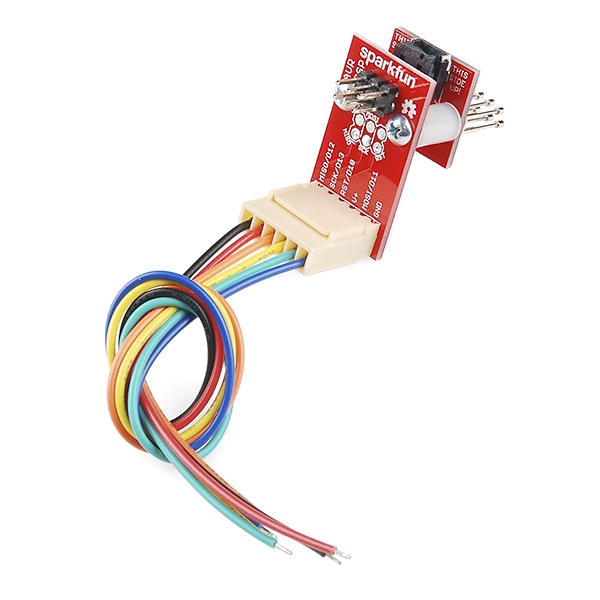
ISP Pogo Adapter Kit Fully Assembled. Y'all tin can connect any of the programmers we mentioned in the previous section to this board.
If you are having problem finding the ICSP pins on your particular Arduino board, you tin consult this website for detailed pinouts of about Arduino related ICs and and then some.
Once you take located thesix ICSP pins on your board, it's time to claw up your programmer to the board. You can use a programming cablevision to connect the two, or, if you don't take a cable, y'all tin just use some male person-to-female jumper wires.
If you are using a developer such as the MKII or the Pocket Programmer, your setup should look something like this:

Click for larger prototype.
Or, if you're using the Arduino as your developer, information technology should expect like this:
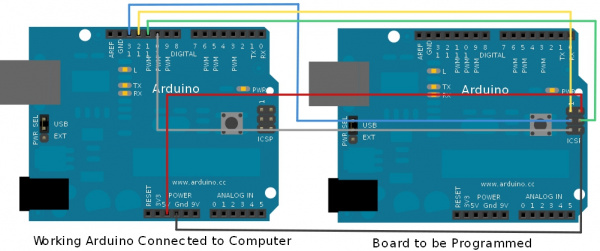
Click for larger image.
Here's a table to help clarify which connections go where.
| Arduino as ISP | AVR Programmer | ISP Header | ATmega328 | ATmega32U4 |
| Vcc/5V | 5V | Pin 2 | Vcc | Vcc |
| GND | GND | Pin half dozen | GND | GND |
| MOSI/D11 | MOSI | Pin 4 | D11 | D16 |
| MISO/D12 | MISO | Pin 1 | D12 | D14 |
| SCK/D13 | SCK | Pin 3 | D13 | D15 |
| D10 | Reset | Pin 5 | Reset | Reset |
Uploading Code - Like shooting fish in a barrel Way
The easy style to upload the bootloader involves using the Arduino IDE. Open up your IDE select the board yous want to program. Then select the developer (if you are using the Arduino as ISP you will also need to select the COM port that the Arduino equally Internet service provider is connected to). So select BurnBootloader. This volition have the board you selected and await upward the associated bootloader in the board.txt file. And then, it will find the bootloader in the bootloader folder and install it. This only works if the board is installed correctly in the IDE and yous have the right bootloader.
If for some reason you want to use a bootloader that isn't installed in the Arduino IDE, visit the nest section. Withal, it's probably easier to but install the bootloader from the Arduino IDE. For those who are curious about settings such as fuse bits, have no fear. Arduino takes intendance of all the messy details for y'all when you burn bootloaders through it.
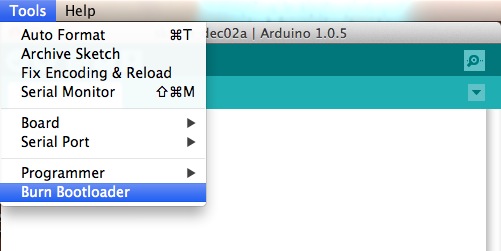
Uploading Code - Hard Way
The hard style is for those people who desire to use the control line. This method may be more preferable if y'all are modifying and recompiling and don't want to take to go along updating the IDE, but otherwise its pretty unnecessary. Once again you will demand to become the programmer, and hook everything up. In this instance we are using avrdude on Windows.
There are two steps to this process. The kickoff pace involves setting the fusebits. Fusebits are the part of the AVR chip that determine things similar whether you are using an external crystal or whether y'all desire brown out detection. The commands listed below are for the Arduino Uno using an ATMega328, they will probably work on some other similar boards such as the Duemilanove, simply make certain you know what you are doing earlier playing with fusebits (NOTE: these fusebits will not work on a iii.3V/8MHz board). All the required fuse bits are listed in the boards.txt file for different boards, but again, if you have a boards.txt file installed then simply use the Easy Manner.
Arduino as Internet access provider: avrdude -P conduct -b 19200 -c avrisp -p m328p -v -e -U efuse:w:0x05:m -U hfuse:w:0xD6:g -U lfuse:w:0xFF:m
AVR Pocket Programmer:
avrdude -b 19200 -c usbtiny -p m328p -v -e -U efuse:west:0x05:thou -U hfuse:w:0xD6:m -U lfuse:w:0xFF:m
The 2nd step is actually uploading the programme.
Arduino as ISP:
avrdude -P carry -b 19200 -c avrisp -p m328p -v -east -U flash:w:hexfilename.hex -U lock:w:0x0F:m AVR Pocket Programmer: avrdude -b19200 -c usbtiny -p m328p -v -e -U flash:w:hexfilename.hex -U lock:westward:0x0F:m
One last bit of info. Every bit we stated earlier, a bootloader is essintially a .hex file. Thus, you tin apply this method to upload and code you wish to your ICs.
How To Add Programs To Mega2560 R3 Bootloader,
Source: https://sparkfuneducation.com/how-to/installing-an-arduino-bootloader.html
Posted by: parkerthavercuris.blogspot.com


0 Response to "How To Add Programs To Mega2560 R3 Bootloader"
Post a Comment